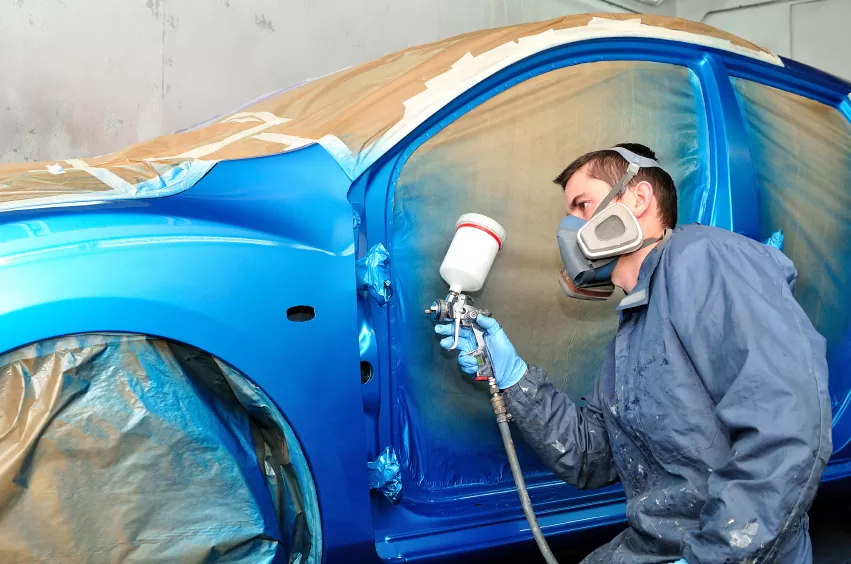
Car paint plays a pivotal role in defining the aesthetic appeal of an automobile while also serving as a shield against the elements. It’s not merely a cosmetic feature but a crucial aspect of vehicle maintenance and preservation. From sleek finishes to vibrant hues, the right choice of paint can transform a car from ordinary to extraordinary.
Beyond the aesthetics, the type of paint chosen can significantly impact a vehicle’s longevity and resale value. Factors such as durability, color retention, and resistance to environmental factors all come into play when selecting the ideal paint for your car. Whether you’re embarking on a restoration project at your nearest auto body shop, considering a custom paint job, or simply seeking to maintain your vehicle’s pristine appearance, gaining knowledge about car paint is the first step towards achieving your automotive aspirations.
The Basics of Car Paint
Car paint serves as more than just a decorative layer on the surface of a vehicle. It’s a complex system designed to protect the underlying metal from corrosion, impact damage, and the harmful effects of UV radiation. At its core, car paint is a composite material consisting of pigments, binders, solvents, and additives, engineered to provide both aesthetic appeal and practical durability. These are the primary functions of car paint:
- Protection: One of the primary functions of car paint is to shield the underlying metal surface from rust, corrosion, and degradation caused by exposure to moisture, salt, pollutants, and other environmental factors. By forming a barrier between the metal and the elements, paint helps prolong the lifespan of the vehicle’s body panels and structural components.
- Aesthetics: Car paint plays a crucial role in defining the visual identity of a vehicle. The color, finish, and texture of the paint contribute to its overall appearance, reflecting the owner’s personal style and preferences. Whether it’s a classic glossy finish, a modern matte look, or a vibrant metallic hue, the choice of paint can significantly impact the car’s visual appeal.
- Enhanced Resale Value: A well-maintained paint job can enhance the resale value of a vehicle. Potential buyers are often drawn to cars with pristine paint finishes, as they signal proper care and maintenance. Conversely, vehicles with faded, chipped, or poorly applied paint may command lower prices in the resale market.
Different Types of Car Paint
When it comes to car paint, there isn’t a one-size-fits-all solution. Different types of paints offer varying levels of durability, finish options, and application methods. Understanding the characteristics of each paint type is essential for achieving the desired aesthetic outcome and ensuring long-lasting protection for your vehicle. Here, we explore some of the most common types of car paint:
Enamel Paint
Enamel paint has been a staple in the automotive industry for decades, prized for its durability and ease of application. Typically oil-based, enamel paints form a hard, glossy finish that provides excellent protection against rust and corrosion. While traditional enamel paints require longer drying times and may yellow over time, modern formulations offer improved color retention and faster curing.
Lacquer Paint
Lacquer paint, once a popular choice for automotive finishes, is known for its high-gloss appearance and smooth finish. Derived from nitrocellulose or acrylic resins, lacquer paints dry quickly and are easy to buff to a mirror-like shine. However, they are less durable than other paint types and may require frequent reapplication to maintain their luster. Lacquer paints are often favored for custom projects and vintage car restorations, where authenticity and aesthetics take precedence over long-term durability.
Acrylic Paint
Acrylic paints have gained popularity in recent years due to their versatility and ease of use. Formulated with acrylic resins, these water-based paints offer excellent color clarity, fast drying times, and resistance to fading. Acrylic paints can be applied with spray guns, brushes, or rollers, making them suitable for both professional and DIY applications. While not as durable as some solvent-based paints, acrylics are an attractive option for budget-conscious enthusiasts seeking a balance between performance and affordability.
Urethane Paint
Urethane paints represent the pinnacle of automotive paint technology, prized for their exceptional durability and resistance to environmental factors. Formulated with urethane resins and cross-linked polymers, these solvent-based paints offer superior adhesion, chemical resistance, and UV protection. Urethane paints are available in a wide range of colors and finishes, including solid, metallic, and pearl effects. While they require specialized equipment and expertise for application, the long-term durability and gloss retention of urethane paints make them a popular choice for high-end automotive finishes.
Water-Based Paint
Water-based paints have emerged as an eco-friendly alternative to traditional solvent-based paints, offering comparable performance with reduced environmental impact. Formulated with waterborne resins and pigments, these paints emit fewer volatile organic compounds (VOCs) during application, making them safer for both users and the environment. Water-based paints provide excellent color accuracy, fast drying times, and easy cleanup, making them suitable for automotive refinishing and custom painting projects. While water-based paints may require additional preparation and application steps, their eco-friendly credentials and performance benefits make them an increasingly popular choice among environmentally conscious auto enthusiasts.
The characteristics and applications of each type of car paint are different and are essential to know for achieving professional-quality results. Whether you’re restoring a collision damage, customizing a modern vehicle, or simply touching up minor imperfections, choosing the right type of paint will help you achieve the desired aesthetic outcome while safeguarding your investment for years to come.
Understanding the nuances of car paint is essential for auto enthusiasts looking to preserve, customize, or restore their vehicles. By delving into the various types of paint, factors influencing choice, and maintenance tips, you can make informed decisions that enhance your vehicle’s aesthetics, protection, and resale value. With this knowledge, the journey towards automotive perfection becomes both rewarding and enduring.
